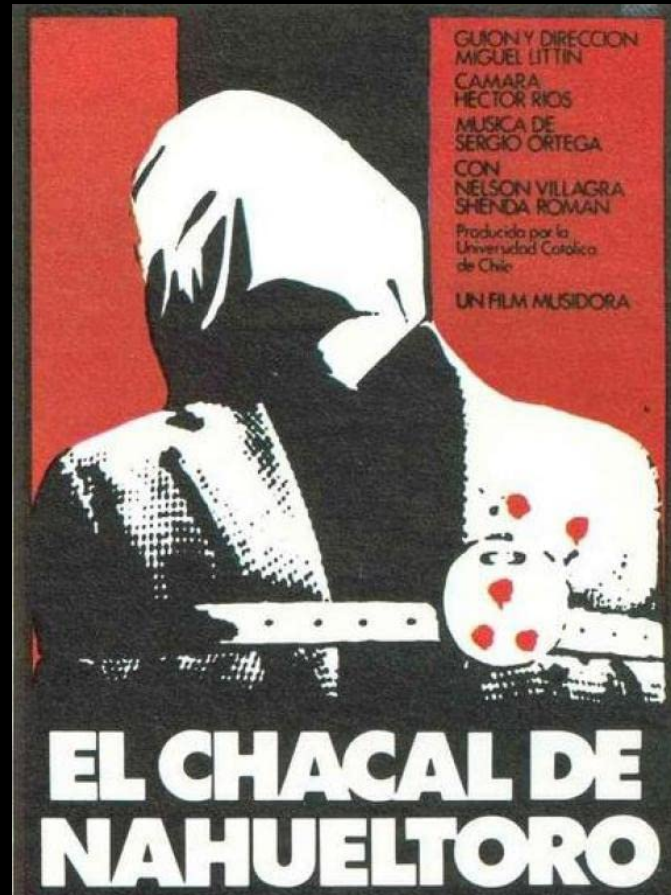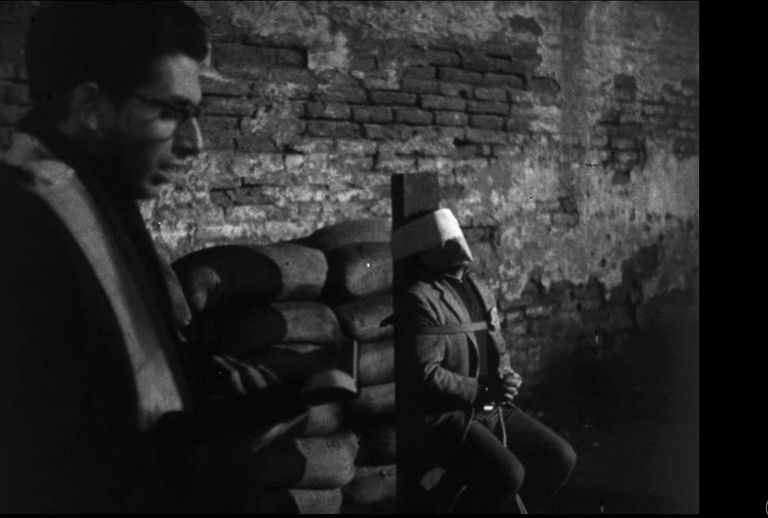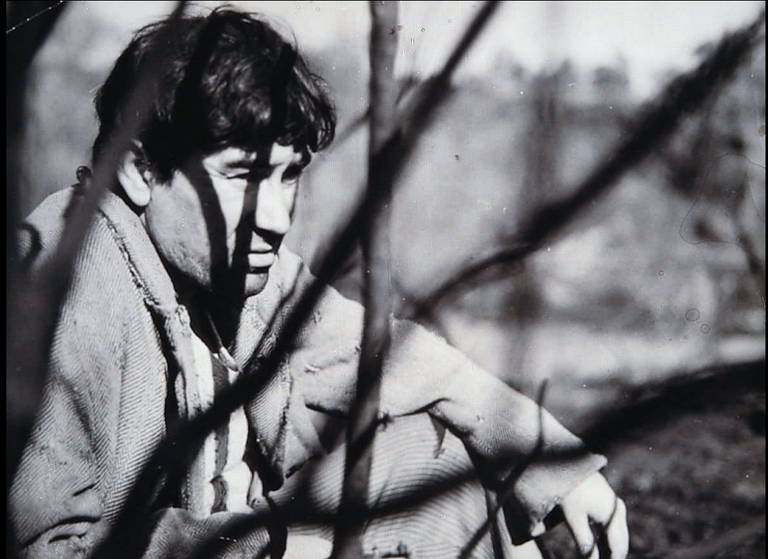
Jackal of Nahueltoro is a film directed by Miguel Littin in the style of what came to be known as the New Chilean Cinema, which received international critical acclaim and was even awarded the OCIC 1970 prize at the Berlin International Film Festival. It is based on a true story, produced by the University of Chile, of a shocking crime that took place in Chile in the 1960s.
The film was shot in 1969, nine years after the aberrant crime and barely six years before the execution of the sentence (execution by firing squad) of his murderer, privileging the historical part as if it were a documentary but, at the same time, criticising the structure of Chilean society at that time and the existence of forms of domination in the countryside that date back to colonial times.

El Chacal de Nahueltoro es una película dirigida por Miguel Littin en la onda de lo que se dio en llamar el Nuevo Cine Chileno, que tuvo una reconocida crítica a nivel internacional siendo incluso Galardonada con el premio OCIC 1970 en el Festival Internacional de Cine de Berlín y basada en una historia real, producida por la Universidad de Chile, de un impactante crimen ocurrido en Chile en la década del 60.
La película fue rodada en el año 1969, nueve años más tarde del aberrante crimen y apenas a seis años de distancia de la ejecución de la sentencia (fusilamiento) de su asesino privilegiando la parte histórico como si fuera un documental pero, a su vez, criticando la estructura de la sociedad chilena de ese entonces y la existencia de formas de dominación en el campo que provienen de tiempos coloniales.

On that occasion, a peasant named Jorge del Carmen Valenzuela Torres, according to the account of the security forces, was arrested for the multiple murder of a peasant woman, Rosa Rivas, widow, cook for a rich landowner - Valenzuela Torres' partner - and her five children, in the town of Nahueltoro (Coihueco) after an argument between them over the woman's inability to collect her widow's pension.
Because of the brutality of the crime committed (the murderer eliminated the entire family by various means, using a scythe, hanging them and even trampling them in a condition of total drunkenness), Valenzuela Toores was nicknamed El Chacal and condemned to death, a sentence executed by a platoon of Chilean Gendarmerie 32 months after his arrest.
Almost illiterate, with an existence of total precariousness throughout his life, the defence lawyers tried by all means to avoid the death sentence, arguing that his ignorance had led him to not understand the extreme seriousness of his crime.
He is famous for the phrase attributed to him when the jury asked him, before sentencing him to death, to justify his deeds by saying that he had never received "enducación de naiden" (education from no one), which shows his extreme ignorance.

En esa oportunidad un campesino llamado Jorge del Carmen Valenzuela Torres según el relato de las fuerzas de seguridad fue apresado por el asesinato múltiple de una mujer campesina Rosa Rivas, viuda, cocinera de un rico terrateniente -pareja de Valenzuela Torres- y sus cinco hijos, en la localidad de Nahueltoro (Coihueco) luego de una discusión entre ambos generada por la imposibilidad de la mujer de cobrar su pensión por viudez.
Por la brutalidad del crimen cometido (el asesino eliminó a toda la familia con distintos medios ya sea usando una guadaña, ahorcándolos e incluso pisoteándolos en una condición de total ebriedad) Valenzuela Toores fue apodado El Chacal y condenado a muerte, sentencia ejecutada por un por un pelotón de Gendarmería de Chile 32 meses más tarde de su detención.
Casi analfabeto, con una existencia de total precariedad durante toda su vida los abogados defensores trataron por todos los medios de evitar la sentencia a muerte argumentando que su ignorancia lo había llevado a no entender la extrema gravedad de su delito.
Es célebre la frase que se le atribuye cuando el jurado le pidió antes de condenarlo a la pena capital que justificara sus hechos diciendo que nunca había recibido "enducación de naiden" (educación de nadie) lo que demuestra su extrema ignorancia.

The film begins with the escape from his home of the future murderer Jorge del Carmen Valenzuela Torres (a remarkable performance by Nelson Villagra) as a teenager and his continuous passing from one job to another like a sequence in a black and white documentary where the images are superimposed with a dramatic cadence.
The making of the film goes through a process that reminds us a lot of the old documentary films where the images of the real events were followed by clippings from old newspapers as if they were slides of the daily police chronicle, telling step by step the hateful and horrendous crime that in principle could not arouse any sympathy.
It was an event that moved and then divided public opinion, at first hostile to any kind of clemency towards the murderer, until finally proposing the substitution of the death penalty for a life sentence, since the murderer had been transformed in 32 months of imprisonment into a new man, regenerated for society.
In this way, the film, extraordinary from every point of view, mixes film reportage with police investigation and journalism, history with sensationalist chronicle; trying to understand the causes that motivated the cold elaboration of the crime and its circumstances with the warm human understanding of a crime that, however abominable it was, compromised the destiny of a man who could not understand the true consequences of his actions, blinded by alcohol.
Throughout, the film reveals the heinous crime (the central crime sequence lasts only a few minutes and the blood is not even visible in the style of neo-realist cinema, which is now almost extinct) and at the same time formulates a severe criticism and a warning to society.
The film is divided into four parts. The first deals with the first years of the murderer's youth and adolescence, the second with the persecution and detention from the moment he commits the atrocious crime, the prison period (32 months) which gradually brings back the human dimension of Jorge del Carmen Valenzuela Torres, who even learns a trade and converts to the Catholic religion, and the last part is dedicated to his death.
The scene in which Valenzuela - already in prison - laughs for the first time and kicks the football back at his fellow prisoners is truly emblematic. This pseudo-human being who was perhaps smiling with joy and innocence for the first time in his life.

La película inicia con la fuga de su casa del futuro asesino Jorge del Carmen Valenzuela Torres (notable actuación de Nelson Villagra) siendo adolescente y de su continua pasar de un trabajo a otro como una secuencia en un documental en blanco y negro donde las imágenes se superponen con una cadencia dramática.
La elaboración del film pasa por todo un proceso que nos recuerdo en mucho a las viejas películas de documentales donde las imágenes de los hechos reales se iban sucediendo a recortes de peródicos pasados como si fueran diapositivas de la crónica policial cotidiana, que van relatando paso a paso el odioso y horrendo crimen que en principio no podía despertar compasión alguna.
Fue un hecho que conmovió y luego dividió a la opinión público, en un principio hostil a cualquier tipo de clemencia hacia el asesino hasta llegar al final a proponer la sustitución de la pena de muerte por la condena a cadena perpetua, dado que el homicida se había transformado en sos 32 meses de encieero en un hombre nuevo, regenerado para la sociedad.
De esa manera la película, extraordinaria desde todo punto de vista, va mezclando el reportaje cinematográfico con la investigación policial y el periodismo, la historia con la crónica sensacionalista; tratando de entender las causas que motivaron la fría elaboración del delito y sus circunstancias con la cálida comprensión humana de un delito que, por más abominable que fuera, comprometía el destino de un hombre que no llegaba a entender las verdaderas consecuencias de su accionar obnubilado por el alcohol.
En todo momento la película va revelando el crimen atroz (la secuencia central del crimen durante muy pocos minutos y ni siquiera se ve la sangre al más puro estilo de un cine neo-realista ya casi extinguido) y a la vez va formulando una severa crítica y una advertencia a la sociedad.
La película está dividida en cuatro partes. La primera se refiere a los primeros años de juventud y adolescencia en la vida del asesino, la segunda a la persecución y dtención a partir del momento en el que comete el atroz crimen, el período carcelario (32 meses) que paulatinamente va devolviendo la dimensión humana de Jorge del Carmen Valenzuela Torres aprendiendo incluso un oficio y convirtiéndose a la religión católica y la última parte dedicada a su muerte.
Es verdaderamente emblemática la escena en la cuál Valenzuela -ya en la cárcel- ríe por primera vez y devuelve con una patada la pelota de fútbol a sus compañeros de cautiverio. Ese pseudo-ser humano que tal vez sonreía con ganas e inocencia por primera vez en su vida.

Nelson Villagra as/como Jorge del Carmen Valenzuela Torres
Shenda Román as/como Rosa Rivas
Héctor Noguera as/como Chaplain / Capellán
Luis Alarcón as/como Judge/Juez
Marcelo Romo as/ como Reporter / Periodista


In El Chacal de Nahueltoro, Miguel Littin reworks a new type of filmmaking consolidated in the 1940s in European cinema and which reached its peak on the American continent with Truman Capote's masterpiece A Sangre Fria (In Cold Blood) in 1966.
A reworked detective story, halfway between documentary and fiction, which more than a reality imposes a rhythm with black and white images that exalt the poverty of the Chilean countryside at the time and the disproportion of human strength in the crime committed, the pathetic loneliness of the murderer, enclosed within the walls of his own world of ignorance and loneliness, his abandonment and alcoholism and the mother-widow's mistake of having trusted a stranger.
Littin's film masterfully rescues the idea that no one is completely bad or completely good, but that everyone carries their own story, even justice itself.
The black and white images have a rich visual content, the wrinkled faces of the murderer and the people who have populated his path, those brushed faces that show a life of sacrifice and ignorance.
A separate paragraph for the scene in which, after the murder, the Jackal carefully places three stones on each corpse, a large one on the belly and a small one on the palm of each hand. When asked at the trial why he did this, he replies: "So that they would stay still".

En El Chacal de Nahueltoro Miguel Littin reelabora un nuevo tipo de cine consolidado en los años 40 hacia adelante en el cine europeo y que en el continente americano alcanza la cúspide con la obra maestra de Truman Capote A Sangre Fria en 1966.
Un hecho policial reelaborado, a mitad camino entre el documental y la ficción, que más que una realidad impone un ritmo con imágenes en blanco y negro donde se exalta la pobreza del campo chileno de la época y la desproporción de la fuerza humana en el crimen cometido, la patética soledad del asesino, encerrado entre las paredes de su propio mundo de ignorancia y soledad, su abandono y alcoholismo y el error de la madre-viuda de haber confiado en un desconocido.
La película de Littin rescata la idea de manera magistral de que nadie es completamente malo ni completamente bueno, sino que cada uno carga su propia historia, hasta la propia justicia.
Las imágenes en blanco y negro tienen un contenido visual riquísimo, las caras pobladas de arrugas del asesino y de la gente que ha poblado su camino, esas caras broceadas que muestran una vida de sacrificios e ignorancia.
Un párrafo aparte para la escena en la cuál después de cometido el asesinato el Chacal coloca cuidadosamente tres piedras sobre cada cadáver, una grande sobre el vientre y una pequeña sobre la palma de cada mano. Cuando le preguntan en el juicio por qué lo ha hecho responde: “Para que se quedaran quietos”.
Credits for extracted images and screenshots of the trailer go to the IMDB site.
Credits for the final banner with the author's signature (modified with the freely distributed Kolour Paint program) go to Pixabay.
Los créditos por las imágenes extraídas y capturas de pantalla del trailer van al sitio IMDB.
Los créditos por el banner final con la firma del autor (modificado con el programa Kolour Paint de distribución libre y gratuita va a Pixabay.

| Blogs, Sitios Web y Redes Sociales / Blogs, Webs & Social Networks | Plataformas de Contenidos/ Contents Platforms |
|---|---|
| Mi Blog / My Blog | Cine & Series de Cabecera. |
| Red Social Twitter / Twitter Social Network | @hugorep |

Upvoted. Thank You for sending some of your rewards to @null. Get more BLURT:
@ mariuszkarowski/how-to-get-automatic-upvote-from-my-accounts@ blurtbooster/blurt-booster-introduction-rules-and-guidelines-1699999662965@ nalexadre/blurt-nexus-creating-an-affiliate-account-1700008765859@ kryptodenno - win BLURT POWER delegationNote: This bot will not vote on AI-generated content
Telegram and Whatsapp